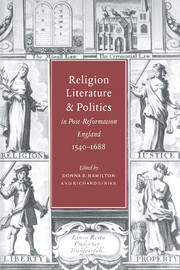Book contents
- Frontmatter
- Contents
- List of contributors
- Introduction
- 1 Sir John Oldcastle as symbol of Reformation historiography
- 2 The “sacred hunger of ambitious minds”: Spenser's savage religion
- 3 Subversive fathers and suffering subjects: Shakespeare and Christianity
- 4 Kneeling and the body politic
- 5 Donne and the politics of devotion
- 6 Catholic, Anglican or puritan? Edward Sackville, fourth Earl of Dorset, and the ambiguities of religion in early Stuart England
- 7 Crucifixion or apocalypse? Refiguring the Eikon Basilike
- 8 Marvell, sacrilege, and Protestant historiography: contextualizing “Upon Appleton House”
- 9 Entering The Temple: women, reading, and devotion in seventeenth-century England
- 10 Contextualizing Dryden's Absalom: William Lawrence, the laws of marriage, and the case for King Monmouth
- 11 Reformation in the Restoration Crisis, 1679–1682
- 12 Shadwell's dramatic trimming
- Index
10 - Contextualizing Dryden's Absalom: William Lawrence, the laws of marriage, and the case for King Monmouth
Published online by Cambridge University Press: 16 October 2009
- Frontmatter
- Contents
- List of contributors
- Introduction
- 1 Sir John Oldcastle as symbol of Reformation historiography
- 2 The “sacred hunger of ambitious minds”: Spenser's savage religion
- 3 Subversive fathers and suffering subjects: Shakespeare and Christianity
- 4 Kneeling and the body politic
- 5 Donne and the politics of devotion
- 6 Catholic, Anglican or puritan? Edward Sackville, fourth Earl of Dorset, and the ambiguities of religion in early Stuart England
- 7 Crucifixion or apocalypse? Refiguring the Eikon Basilike
- 8 Marvell, sacrilege, and Protestant historiography: contextualizing “Upon Appleton House”
- 9 Entering The Temple: women, reading, and devotion in seventeenth-century England
- 10 Contextualizing Dryden's Absalom: William Lawrence, the laws of marriage, and the case for King Monmouth
- 11 Reformation in the Restoration Crisis, 1679–1682
- 12 Shadwell's dramatic trimming
- Index
Summary
In the opening lines of Absalom and Achitophel John Dryden depicts a polygamous golden age when men freely spread their seed, unencumbered by the Christian law of marriage:
In pious times, e'r Priest-craft did begin,
Before Polygamy was made a sin;
When man, on many, multiply'd his kind,
E'r one to one was, cursedly, confind:
When Nature prompted, and no law deny'd
Promiscuous use of Concubine and Bride;
It was under this dispensation that Absalom, “so beautiful so brave,” was born to one of King David's concubines. Dryden's Absalom represents Charles II's illegitimate son James, the duke of Monmouth, who had been born to a Welshwoman called Lucy Walter. Charles had bedded her in 1649, during his exile in France. Now, in the Exclusion Crisis of 1679–81, Monmouth, “the Protestant duke,” staked a claim to the throne against “the Catholic duke,” the king's brother and heir, James, duke of York. The fate of Protestant England, so it seemed to the Whigs, was in the balance because Monmouth was barred from the throne by his illegitimacy. But what if Monmouth was not “illegitimate” after all? What if “promiscuous use of concubine” was no sin? Dryden ironizes a libertine and anticlerical view that nature's laws are more liberal about sexual morality than those sanctioned by the church. By imposing a ceremonial apparatus upon marriage, the church had usurped control over the laws of bastardy and inheritance. By the purer law of nature the duke of Monmouth was, simply, his father's eldest son.
- Type
- Chapter
- Information
- Publisher: Cambridge University PressPrint publication year: 1996
- 1
- Cited by

